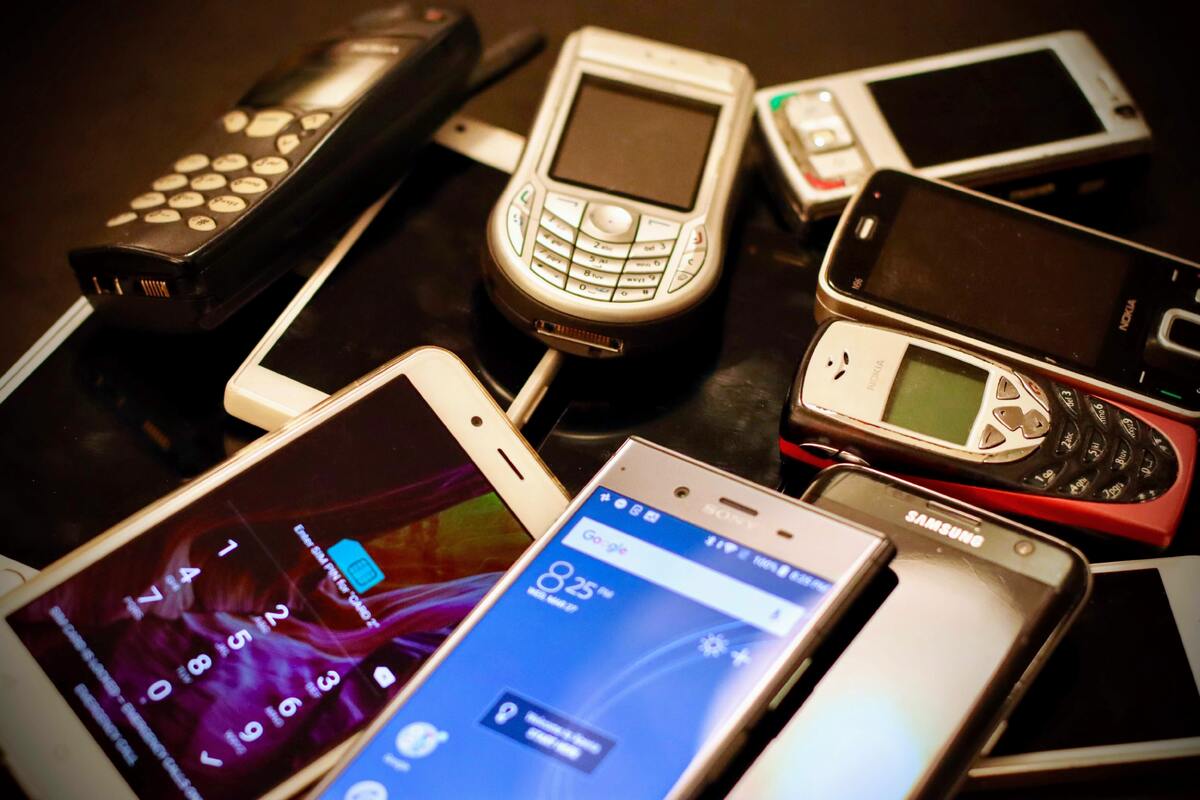You are viewing 1 of your 3 free articles for this month.
Get the knowledge: How to make better choices about electronics
Tech is essential to modern life, but as our appetite from new products and upgrades grows, so do the environmental and social impacts. What are the issues and how can they be tackled?

Gadgets, devices, tech, appliances…the surge in availability and uptake of electronic and electrical equipment over the past few decades has been transformational. Our personal love affair with devices, from mobile phones to large-screen televisions, as well as domestic appliances, seems to know no bounds. At work, most jobs now depend on some aspect of electronic or electrical technology too.
And tech promises to propel us towards future benefits, by delivering digitalisation and artificial intelligence that promise to revolutionise many aspects of modern life, including energy, transport and food systems. The global consumer electronics market is estimated to be worth $1trn per year.
While we enjoy the convenience, efficiency and connectedness, it is important to remember electronic and electrical equipment (collectively known as EEE) have significant sustainability impacts. These include:
- A poor record in protecting the human rights and health and safety of workers manufacturing products, and dismantling them after use.
- Use of large volumes of scarce resources, including certain metals, minerals and water.
- Loss of those resources through both the hoarding of devices and the large amounts of waste generated, that is difficult to manage and ends up in landfills.
- The energy needed to make and use products and the associated carbon footprint.
A number of governments are taking action to tackle these problems, either by introducing legislation or other mechanisms to encourage better practices by businesses. Companies too have introduced schemes to try to reduce the negative impacts and better communicate social and environmental credentials of products.
But the sheer size of the market, and continued growth, means there are some big challenges to overcome. Knowing more about these challenges should help people make more sustainable choices when it comes to EEE and sustainability.
Human rights and worker health
Human rights, especially at factories in developing countries that supply EEE brands, has been a concern for some time.
The Business and Human Rights Resource Centre, an independent information service, tracks the performance of over 10,000 companies. Its detailed dataset for 40 tech companies indicates that just under half do not have human rights policies and just over half have not signed up to the UN Global Compact, a voluntary initiative for CEOs to commit to ten universal sustainability principles (six of which protect human rights and labour).

In 2021, the Campaign for Accountability (CfA) filed a formal complaint with US Customs and Border Protection claiming Apple used forced labour in products it ships to and sells in the US. Its research arm, the Tech Transparency Project regularly reports on the company’s treatment of workers. Apple is far from the only offender. Exploitative conditions have also been reported at Samsung, including the use of child labour, abusive working hours and poor accomodation.
Samsung was also involved in a health and safety case, including exposure to toxic substances in the manufacture of semiconductor chips and LCD panels. Several hundred South Korean workers, mainly women, suffered a range of problems, including miscarriages and cancer. It was also reported that some children born to exposed workers also suffered.
Nearly half of UK households have up to five unused electronic devices
In July 2018, after ten years of delay, Samsung accepted an arbitration proposal to compensate the workers. Baskut Tuncak, the then UN Special Rapporteur on the implications for human rights of hazardous substances and wastes, encouraged Samsung and other businesses in the electronics sector to further enhance the protection of workers throughout their global operations”
In 2018, Good Electronics, a not-for-profit group of organisations and individuals concerned about human rights and sustainability issues in the global electronics supply chain, published a report showing that many workers in the electronics industry are not properly informed or trained on handling the many toxic chemicals used in factories.
The group said such practices amounted to worker exploitation. The report said the cases it identified implicated governments and companies in both the world’s richest and poorest countries along the lifecycle of electronic goods – from the extraction of raw materials to the manufacture of electronic components and products, to recycling and recovery operations.
Heavy resource use
Electronic products depend on large volumes of resources, such as:
- Metals and minerals, including from war zones, known as conflict minerals, like gold, tantilium, and tungsten.
- Toxic chemicals like gallium arsenide.
- Rare elements like indium.
- Plastics.
Mining for raw materials uses large volumes of water and also causes pollution. A lot of electronics raw material mining and component manufacturing stages happen in the global South, abstracting and polluting already stressed water sources.
Estimates of water footprints for electronic products include:
- 31,500 litres for a computer
- 12,760 litres for a generic smartphone
- 32 litres for a microchip
|
Pace view of what a circular electronics industry looks like:
|
Organisations promoting more sustainable electronics include the Good Electronics Network, and the Global Electronics Council, which publishes sustainability reviews on the impacts of chemicals, climate, plastics, social factors and waste.
According to the UN, fast-moving innovation, expanding product ranges, short life cycles and a lack of viable repair options has driven growth in EEE. Based on this, ways of conserving the resources tied up in EEE include:
- Buying fewer products - choose preowned, refurbished goods instead.
- Making do with current technology for longer - perhaps the upgrades aren’t worth the planetary cost.
- Make owned products last longer - check out repair options.

Another big issue is built in obsolescence. A European Environment Information and Observatory Network report on Electronics and obsolescence in a circular economy indicates the current shortfall in consumer expectations for how long products should last and what they actually deliver (see table below).
Product |
Designed (years) |
Consumer expectations |
Actual |
| Phone | 2 | 4.5 | 1.8 |
| TV | 25 | 10.5 | 7.3 |
| Washing machine | 10 | 12.5 | 8.3 |
| Vacuum cleaner | 10 | 10 | 8 |
| Fridge | - | 12.5 | 8.5 |
Last year Good Electronics published a State of Play and Roadmap report to feed into the EU’s Re-sourcing project, which aims to tackle both substandard working conditions and human rights violations in the sector, and risks associated with conflict minerals, artisanal mines, and mica mining. The overall aim is to define, implement and verify responsible sourcing practices across the supply.
While consumers wait for this to happen, there are alternatives on the market, such as Fairphone, which tackle issues including the treatment of workers at its suppliers. But these products represent a relatively small and new part of the technology market.
E-waste mountain
As well as huge growth in demand for EEE, the sector produces the fastest-growing waste stream, creating nearly 60m tonnes of waste in 2021, according to the public-private collaboration Platform for Accelerating the Circular Economy (Pace).
That figure is expected to increase to 75m tonnes by 2030. The group notes that EEE waste contains products that have been discarded prematurely, along with raw materials, that has a value of $60m (this is mainly based on the value of iron, copper and gold). Currently, less than 20% of global waste is collected and recycled or managed appropriately.
The rest is lost to landfill (it is estimated that 2% of all landfills in the US consists of waste EEE) or shipped to low income countries. In many of these countries an informal economy has built up to dismantle and extract valuable resources, but often without adequate protection for workers or the environment, leading to impacts on health and pollution.
It is estimated that 50-80% of e-waste sent to electronics recycling centres in the US and Europe end up in other nations, as it’s cheaper to get labour elsewhere to separate the materials.
Circular solutions
One way to tackle resource use and waste generation is to adopt circular approaches to electronic and electrical products. So far, use of recycled materials in electronics has proved problematic as there is, as yet, insufficient recycled materials available.
But as more sectors adopt circular approaches there is likely to be more recycled feedstock available. Also more companies are setting up services to collect and recycle EEE because of the value of the waste.
Recycling materials from electronics is also challenging because of the complexity of product design, the way that they are built (they are not easy to dismantle for processing), and the vast array of materials they contain that can be difficult to separate.
In addition, electronics often contain hazardous substances, such as lead solder, certain flame retardants and plastics additives. These chemicals pose little threat when they are contained within the devices, but present significant risks to anyone dismantling and recycling.
These substances need to be removed during recycling, so they do not reenter material streams, where they wouldn’t be labelled or identified, presenting a potential risk to people buying products made of recycled materials.
New business models
A report by Pace for the World Economic Forum and UN E-Waste Coalition recommended that the tech sector rethink its business models, shifting away from linear sales, to as-a-service model as this would support the recirculation of materials, as well as extend the life of products.
Companies are looking for circular business models to keep materials in use as long as possible. Dell, for example, achieved a certified closed-loop process which takes plastics from recycled electronics and processes them for use as plastic parts in new computers. The company has used millions of pounds of recycled plastic in more than 125 different product lines.
Convincing consumers
Making sure the public is engaged with these changes is critical. WEF notes that while consumers look for more sustainable choices, there is still a perception that use of recycled or more sustainable materials in new products means they are of lower quality. It is important that brands and the media convince people otherwise.
People don’t only need help with their purchases, they also need better information on repair, recycling and disposal. Businesses and governments might also consider incentives.
There are a growing number of centres dedicated to recycling electronics locally. The best way to find one is to search for ‘electronic recycling’ [how can you ensure they handle your products sustainably?].
Hoarded e-waste
An Ipsos Mori survey for the Royal Society of Chemistry found that nearly half of UK households have up to five unused electronic devices – such as mobile phones, computers, smart TVs, MP3 players or e-readers. (The number increases to ten for people between 16-24). The survey also showed that more than 80% of people have no plans to recycle or sell on their devices after they fall out of use.
The RSC notes that natural sources of six of the elements found in mobile phones are set to run out within the next 100 years. Nearly 60% of people said that knowing this would make them more likely to recycle old devices.
The fact is, many materials used in electronics can be recovered and recycled, and more could be if circularity is considered during design. For example, copper, aluminium, gold, silver and zinc are 100% recyclable and can be recycled a repeated number of times with no loss in performance. Other metals like lithium and cobalt are also recyclable, although there is some degradation.
The Ellen MacArthur Foundation set out its circular vision for consumer electronics in 2017, noting that cloud computing and data storage mean consumer access to their data is independent of the device, which should make them happier to let go of their devices (rather than hoarding them).
Regulatory measures
The electronics industry is also regulated in several ways. The Restriction of Hazardous Substances directive bought in by the EU in 2011 has been updated several times, as more chemicals are restricted.
Similar regulations have been adopted around the world, especially in Asia, as governments work to protect citizens from exposure to toxic materials. The EU’s Waste EEE directive aims to contribute to sustainable consumption and production, and the bloc has recently proposed an update to its Batteries directive.
In terms of product life and repairability, governments are currently in the process of pushing tech companies to create goods that have longevity or can be upgraded.
The EU has demanded the USB actually be a universal charger solution, helping reduce the planned cord obsolescence that’s in-built into so much of tech.
France has created a tech repairability index. This requires tech companies to provide a score rating on how repairable their product is (Product life span article).
Under EU and UK right-to-repair laws, manufacturers must make spare parts for electrical appliances available within two years of all model launches, and then for between seven and 10 years after the model is discontinued, depending on the type of product.
This currently applies to dishwashers, washing machines, washer-dryers, dryers, fridges, freezers, televisions and other electronic displays for home use.
Some companies, like HP and Dell now provide access to firmware, spare parts and tutorials, meaning that the average consumer will be able to upgrade their goods with a little bit of work.
Energy use
Many authorities also require companies to label products with energy efficiency ratings, so that consumers can identify devices and equipment that will help them save on their energy bills.
The repair community group Restart investigated the greenhouse gas emissions for a range of products – both during manufacture and use. For the majority of items, most of the global warming impact occurred before it was used for the first time.
An average laptop creates about 328kg of embodied CO2e during its life (similar to the figure for flying from London to New York). Just over 80% is from the manufacturing stage, with the remainder associated with use (based on a four year life span).
The investigation also showed how difficult it is to identify that information, as it is not data manufacturers tend to publish. But from what could be assessed, the ability to use devices for longer, including repair, has a big impact.
Additional reporting by Jason Dike
Check it out
For more information on these issues:
- The Campaign for Accountability (CfA) formal complaint submitted to the US Customs and Border Protection claiming Apple used forced labour in products it ships to and sells in the US.
- CfA research arm, the Tech Transparency Project regularly reports on Apple’s treatment of workers.
- The Good Electronics network brings together groups and individuals that are concerned about human rights and sustainability issues in the global electronics supply chain.
- The Good Electronics paper on Exploitation by deception in the electronics industry
- The Global Electronics Council sustainability reviews provide greater detail on the impacts of chemicals, climate, plastics, social factors and waste related to electronics.
- A European Environment Information and Observatory Network report on Electronics and obsolescence in a circular economy indicates the current shortfall in consumer expectations for how long products should last and what they actually deliver.
- Good Electronics State of Play and Roadmap on electronics to feed into the EU Re-sourcing project.
- The EU’s Re-sourcing project aims to tackle both substandard working conditions and human rights violations in the sector, and risks associated with the metals sourced from war zones (known as conflict minerals) or artisanal mines, and mica mining.
- Fairphone aims to tackle issues including the treatment of workers at its suppliers, resource use and repairability.
- The Platform for Accelerating the Circular Economy (Pace) brings business, government and civil society leaders together to develop a collective circular economy agenda and drive action.
- Pace 2019 report for the World Economic Forum and UN E-waste Coalition on a new circular vision for electronics.
- WEF article on how electronics can trigger a more circular, sustainable world
- The Circular Electronics Partnership is an industry initiative bringing leaders in tech, consumer goods and waste management companies together to identify how to tackle EEE waste.
- The Pace, Sitra, BDU Consumer impact action panel is working to involve consumers in circular electronics
- Sitra is a Finnish organisation working to facilitate positive change through collaborations.
- Ipsos Mori survey for the Royal Society of Chemistry on resources used in electronic devices and consumer attitudes to recycling.
- Ellen MacArthur Foundation initial overview of how the principles of a circular economy could be applied to the electronics industry
- Not-for-profit WEEE Forum campaign to counter illegal trade in waste electrical and electronic equipment (WEEE)
- The EU’s Rohs directive restricts the use of hazardous substances in electrical and electronic equipment to protect the environment and public health.
- The EU’s Waste EEE directive provides rules on the treatment of waste EEE, to contribute to sustainable consumption and production.
- The EU’s proposed revision of its Batteries directive aims to ensure batteries are sustainable and safe.
- France’s repairability index helps consumers identify how repairable products are across five categories (smartphones, laptops, televisions, lawnmowers, porthole washing machines).
- US EPA basic information about electronics stewardship.
- Recycle your electricals, led by Material Focus (formerly the WEEE Fund) is a website that aims to make it easier for everyone to reuse and recycle unwanted electricals.
- The Restart Project is a people-powered social enterprise aiming to help people fix faulty electronics.
- Restart assessment of greenhouse gas emissions from devices over their lifetime, including following repair.
- Ifixit an online resource to help people fix their gadgets, including replacement parts, precision tools, and free step-by-step instructions from in-house repair experts.
Related
Activate employees
Find out how OckiPro membership engages employees to deliver sustainability impact.
Get Involved
There are many ways to get involved with Ocki and its community. To find out more, click the button below




